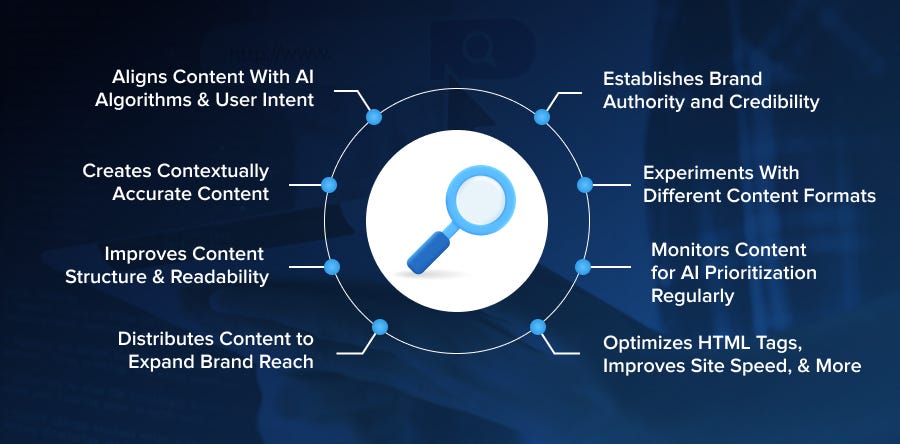Introduction
Search Engine Optimization (SEO) has long been the cornerstone of digital visibility. But as artificial intelligence (AI) reshapes how content is created and consumed, a new paradigm is emerging: Generative Engine Optimization (GEO). GEO is the practice of optimizing content not just for traditional search engines like Google, but for AI-powered generative engines—tools like ChatGPT, Gemini, Claude, and Perplexity that deliver synthesized answers instead of links. let’s see Generative Engine Optimization.
This blog explores the rise of GEO, how it differs from traditional SEO, its implications for content creators and marketers, and strategies to stay ahead in this evolving landscape.
What Is Generative Engine Optimization (GEO)?
GEO refers to the process of structuring and crafting content so that it is discoverable, usable, and referenced by generative AI systems. Unlike SEO, which focuses on ranking in search engine results pages (SERPs), GEO aims to ensure that content is included in AI-generated responses.
Key Goals of GEO:
- Be cited or referenced in AI-generated answers
- Influence the output of generative models
- Ensure brand visibility in conversational interfaces
Why GEO Matters in 2025 and Beyond
1. Rise of AI Search Interfaces
Generative engines are replacing traditional search for many users. Instead of browsing links, users receive direct answers.
2. Zero-Click Search
Users increasingly get what they need without clicking through to websites. GEO ensures your content is part of that answer.
3. Voice and Chat Interfaces
Smart assistants and chatbots rely on generative models. GEO helps your content surface in these environments.
4. Content Saturation
With AI generating massive volumes of content, GEO helps your original work stand out and be recognized.
How GEO Differs from Traditional SEO
| Aspect | SEO | GEO |
|---|---|---|
| Target | Search engines (Google, Bing) | Generative AI models (ChatGPT, Gemini) |
| Output | Ranked links | Synthesized answers |
| Optimization | Keywords, backlinks, metadata | Semantic clarity, factual accuracy, source credibility |
| Metrics | Click-through rate, SERP ranking | Citation frequency, model recall, brand mentions |
| Tools | Google Search Console, SEMrush | AI model testing, prompt engineering, LLM analytics |
Key Elements of GEO Strategy
1. Structured, Semantic Content
Generative models prefer well-organized, semantically rich content. Use:
- Clear headings and subheadings
- Bullet points and numbered lists
- Schema markup and structured data

2. Factual Accuracy
AI models prioritize reliable sources. Ensure:
- Up-to-date information
- Cited references
- Verified statistics
3. Authoritativeness
Build domain authority through:
- Expert authorship
- High-quality backlinks
- Consistent publishing
4. Conversational Tone
Generative engines favor content that reads naturally. Use:
- Clear, concise language
- FAQs and Q&A formats
- Examples and analogies
5. Multimodal Content
Include:
- Images with alt text
- Videos with transcripts
- Infographics and charts
GEO Optimization Techniques
✅ Use Natural Language
Write in a way that mimics how users ask questions. Example:
- Instead of “Best laptops 2025,” use “What are the best laptops for students in 2025?”
✅ Answer Specific Questions
Generative engines love direct answers. Include:
- Definitions
- How-to guides
- Pros and cons
✅ Create Evergreen Content
Focus on topics that remain relevant over time. Update regularly.
✅ Leverage Citations
Link to reputable sources and encourage others to cite your content.
✅ Monitor AI Outputs
Test how your content appears in tools like ChatGPT or Perplexity. Adjust based on visibility.
Tools for GEO
- ChatGPT / Gemini / Claude – Test how your content is referenced
- Perplexity.ai – Analyze citations and source usage
- SurferSEO / Clearscope – Optimize for semantic relevance
- Google’s Structured Data Testing Tool – Validate schema markup
- AI Content Detectors – Ensure originality and reduce duplication
Challenges in GEO
⚠️ Lack of Transparency
Generative engines don’t reveal ranking algorithms or citation logic.
⚠️ Content Attribution
AI may paraphrase or summarize without crediting the source.
⚠️ Model Bias
AI models may favor certain domains or formats.
⚠️ Rapid Evolution
GEO strategies must adapt to frequent model updates and changes.

Case Studies
🧠 WebMD
Frequently cited in health-related AI responses due to structured, authoritative content.
🛍️ Amazon
Product pages often referenced in AI-generated shopping guides.
📚 Wikipedia
A top source for factual data in generative outputs.
Future of GEO
1. GEO Analytics Platforms
New tools will emerge to track how often content is cited by AI.
2. AI-First Content Strategies
Brands will create content specifically for generative engines.
3. GEO Certifications
Websites may earn badges for being AI-friendly or frequently cited.
4. Integration with Voice Search
GEO will power responses in Alexa, Siri, and Google Assistant.
Conclusion
Generative Engine Optimization is the next frontier in digital marketing. As AI becomes the primary interface for information retrieval, businesses must rethink how they create and structure content. GEO isn’t just about visibility—it’s about being part of the answer. By embracing this shift, marketers and creators can ensure their content remains relevant, discoverable, and impactful in the age of AI.





